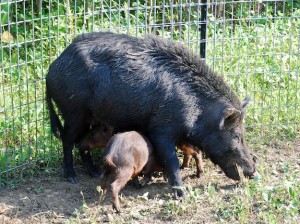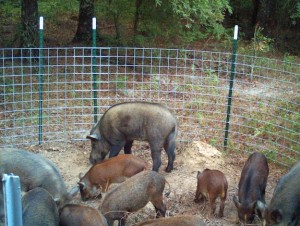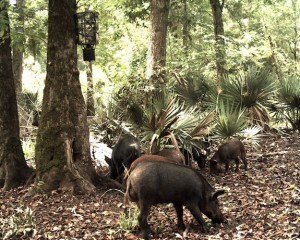Hunters dealing with feral hog explosion

Playing catch-up is a difficult task in almost every endeavor. That’s especially true when the issue at hand is the explosion in the feral hog population.
I heard a story last week from a hog hunter who had trapped and relocated a group of hogs to the Tombigbee River swamp in the 1980s before everyone realized what a destructive force an unchecked wild hog could become.
The complicit owner of the swamp told the hog hunter, “If I knew then what I know now, I’d have killed you and the hogs.”
While that statement might be a bit over the top, landowners with feral hog infestations know the damage these eating machines can wreak.
Early in the previous decade, wildlife managers and landowners knew something had to be done about the burgeoning wild hog population.
Since 2003, Steve Ditchkoff, the “William R. & Fay Ireland Distinguished Professor” at Auburn University’s School of Forestry and Wildlife Sciences, has been involved in wild pig research. In 2004, Ditchkoff and noted wild pig expert Jack Mayer of the Savannah River National Laboratory in Georgia introduced the International Wild Pig Conference; it has been held every two years since. This year’s conference, held recently at the Embassy Suites in Montgomery, hosted 250 attendees from all over the world.
 “We know the wild pig problem is growing,” Ditchkoff said during a break at the conference. “We have pigs popping up in areas where they were not before. Damage has to be increasing. We were talking about how poor our damage estimates are. $1.5 billion in agriculture damage is the estimate we always use nationally – that’s based on $300 per pig – but that’s a guess. Some people project the damage is in the multiples of billions. In Alabama, the estimate is between $50 and $100 million. We think that’s a conservative estimate.”
“We know the wild pig problem is growing,” Ditchkoff said during a break at the conference. “We have pigs popping up in areas where they were not before. Damage has to be increasing. We were talking about how poor our damage estimates are. $1.5 billion in agriculture damage is the estimate we always use nationally – that’s based on $300 per pig – but that’s a guess. Some people project the damage is in the multiples of billions. In Alabama, the estimate is between $50 and $100 million. We think that’s a conservative estimate.”
Ditchkoff said the greatest concentration of pigs in Alabama is in the lower coastal plains below I-85 with significant densities north of Mobile Bay in the Mobile-Tensaw Delta.
“We’re starting to get a measles sort of distribution across the state with little spots here and little spots there,” he said.
Ditchkoff said the distribution problem has been exacerbated by people with trucks and trailers.
“People ask how fast pigs spread,” he said. “One of our presenters said, ‘They move at 70 miles per hour – in the back of a pickup truck.’ Pigs move extremely slowly on their own. This is a human problem. The vast majority of these pockets popping up are due to hunters releasing them.
“Even then, can you really stop them? We’ve got people who say, ‘We want pigs and we don’t care how it’s going to affect anybody else.’”
When feral pigs show up in an area, Ditchkoff said the only viable option to deal with the infestation is trapping with a plan.
“Strategic trapping is the only way to do it,” he said. “I don’t care about how many pigs you kill. I only care about how many you left behind that can reproduce.
“We developed a trapping strategy at Auburn and cleared 20,000 acres at Fort Benning (Ga.). You can do it if you do it right. It’s not a new mouse trap. You use game cameras, bait and corral traps.”
Ditchkoff said they developed a five-step process: find the pigs, identify the pigs, acclimate the pigs to traps, trap them and monitor the area afterward.
 “You’ve just got to make sure that when you trap them you get them all,” he said. “Patience is the key. Identifying them is easy. Baiting has to be done strategically. You’ve got to make sure you’ve got every pig in that sounder. If the sounder is too big, you have to build a bigger trap or add traps.
“You’ve just got to make sure that when you trap them you get them all,” he said. “Patience is the key. Identifying them is easy. Baiting has to be done strategically. You’ve got to make sure you’ve got every pig in that sounder. If the sounder is too big, you have to build a bigger trap or add traps.
“Then we’ve got to set the triggers to make sure that when the door falls, all the pigs are in the trap. Again, being patient is the key.”
Ditchkoff said the traps can be as simple as a trap with a stick, string and guillotine door to the modern traps that can be monitored and executed by smartphone. The smartphone user gets a video feed from the trap and then dials a number and enters a code to close the trap door.
Because pigs have such a high reproduction rate at up to two litters per year with four to eight piglets per litter, trying to control the population through hunting will likely be futile.
“Hunting won’t do it,” Ditchkoff said. “You have to kill about 70 percent of your pigs just to hold it steady. If you’ve got 100 pigs, you’ve got to kill 70 this year, 70 next year and 70 the year after that just to maintain.”
Ditchkoff said his team discovered territorial behavior with the pigs at Fort Benning. Sounders would stick to and defend their territories. With whole sounder removal, trappers can start working in a grid fashion to remove the population.
“If you take the whole sounder, you don’t educate any, and they’re smart critters,” he said. “That way, you’re dealing with novice pigs all the time.”
Chris Jaworowski, wildlife biologist with the Alabama Department of Conservation and Natural Resources’ Wildlife and Freshwater Fisheries Division (WFF), said the wild pig conference covered control methods from toxicants and contraceptives to thermal imaging and traps with remote technology.
“Some people think toxicants and contraceptives could be the cure-all for pigs,” Jaworowski said. “That was discussed – that it was not true. These are just more tools for the toolbox. Right now there are no approved species-specific toxicants (poisons) or contraceptives in the United States. We’re hoping that within three, five or 10 years those tools will be available to everyone.”
Jaworowski thinks one important bit of news highlighted during the conference is that the U.S. Congress has allocated $20 million for feral hog control.
“That’s a huge step,” he said. “We’ve finally had Congress recognize that the nation has a pig problem, but this is a long-term process. This is just the tip of the iceberg.”
Jaworowski said Auburn graduate student Rachel Conley participated in a research project that sought to identify the distribution of wild pigs across Alabama. Conley enlisted the help of WFF’s conservation enforcement officers to map wild pig populations in each county.
Conley’s research indicated feral hogs are in 64 of Alabama’s 67 counties with 36 counties reporting an increase in the pig population in the last five years. That pig distribution covered 38.3 percent of the land base in Alabama.
Jaworowski, who manages the Lowndes County Wildlife Management Area, said WFF is looking at ways to deter people from moving live wild hogs. It is already against the law to transport wild hogs, but it is happening anyway. WFF Director Chuck Sykes has proposed a change to feral hog regulations that requires that any hog caught by trap or by dogs must be killed at the site of capture before it is moved.
“We’ve got to get increased fines and penalties,” he said. “We’ve got to get people to look at risk versus reward. It’s got to be more expensive to get caught trying to move them.
“And we’ve got to teach landowners how to trap hogs. The most beneficial method is to make it a collaborative effort where all the landowners in an area are on the same page with trapping and control programs.”
That brings up the question of what to do with the feral hogs once reduced to bag. Wild pigs can carry pseudorabies and brucellosis, so proper handling is a must.
“We recommend using gloves when cleaning wild pigs, and stay away from the reproductive tract,” Ditchkoff said. “I’ve eaten a bunch of them, and they make the best sausage in the world. Most people can’t figure out why wild hog sausage is so good. But if you go to the store and buy sausage, that’s the worst meat off the pig. With a wild pig, you use the hams, backstraps and tenderloins. You’re grinding that into sausage, and it is delicious.”
David Rainer is an outdoors columnist for the Alabama Department of Conservation of Natural Resources.
